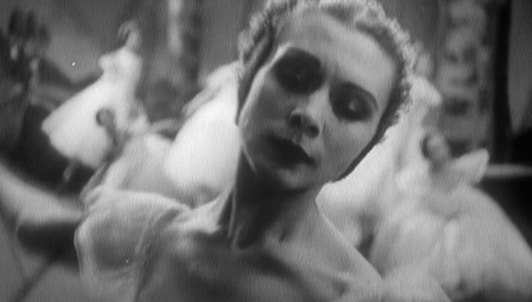The ballet was in fact a reworking by its choreographer, Mikhail Fokine, who several years earlier had created Chopiniana, his hommage to the Romantic ballets of the past. The work does not have a story – as Karsavina says in the introduction, it is a 'Romantic reverie'. The only male dancer (John Field in this recording) plays the role of a Poet. The corps de ballet and the three female soloists, Alicia Markova, Violetta Elvin and Svetlana Beriosova, have strong links with the Ballets russes and Russia.
Markova, born in England, was the Ballets russes's baby ballerina when she joined in 1925, aged fourteen. She went to perform both Les Sylphides and Giselle all over the world. Violetta Elvin (born Prokhorova) trained at the Bolshoi Ballet School and performed with the company before coming to England and joining the Sadler's Wells Ballet, where she danced until her retirement from the stage in 1956. Svetlana Beriosova was born into a ballet family; her father was dancer, ballet master and director Nicholas Beriozoff, who had worked closely with Fokine in the Ballets russes de Monte Carlo in the late 1930s. Young Beriosova studied with teachers who had danced with the Diaghilev company and joined the Royal Ballet in the 1950s to become a much loved ballerina. All who saw her Lady Elgar in Frederick Ashton's Enigma Variations (1968) will never forget it. The corps de ballet, which plays such an important role in Les Sylphides, were rehearsed by another Diaghilev dancer, Lydia Sokolova, who danced with his company for many years and was in facr renamed Sokolova by Diaghilev himself, having been born in England as Hilda Munnings.
This Les Sylphides is the first film of a complete ballet in the BBC archives. It is important to remember that in the 1950s television was black and white, video recording had not arrived, studios were small, and the cameras, full of valves, were both heavy and bulby. The visual effects and superimposing of one image on another in both Les Sylphides and the recording of Giselle presented here seem very Heath Robinson in this digital age, but they are still effective. In both films the directors have reworked the stage production for the screen – the corps de ballet groupings and the soloists' entrances are made to suit the camera. In Les Sylphides, for example, the dancers enter and exit past the camera, and in Giselle good use is made of foreground trees, and dancers are placed close to camera allowing us, the viewers, to see their reactions to what is happening in the drama. All this would be impossible on the stage, as the orchestra pit would get in the way.
There is no record of the orchestra that played in the recording of Les Sylphides, but as Eric Robinson is credited as conductor, it is likely to have been the BBC Television Orchestra. For Giselle the music was pre-recorded by the Covent Garden Orchestra, conducted by Hugo Rignold. Giselle is the only ballet that has an unbroken performance tradition from its first night until today. It is the the story of the village girl who falls in love with a prince and, on discovering that he has deceived her, goes mad and dies. When the prince visits her woodland grave, the Queen of the Willis (the spirits of the girls who have been betrayed by men) commands him to dance himself to death, but Giselle appears and saves him. It is perhaps the most popular and best known of the ballet from the Romantic era. The first performance was at the Paris Opéra on 28 June 1841, and it was choreographed by the Opéra's ballet master, Jean Coralli, and Jules Perrot to a wonderful score by Adolphe Adam.
Giselle dates from a period when plots feature a fascination with the supernatural. A corps de ballet of spirits , sylphs or Wilis enslaves the hearts of men, making it impossible for them to live in the real world. The Willis were, and still are, dressed in long white skirts and danced in a new fluid style that caused a sensation for the audiences. The great stars of the Romantic era were Carlotta Grisi, Fanny Essler and Marie Taglioni, and it was Grisi that created the role of Giselle.
The first performance was a triumph, and Giselle was soon being staged all over Europe. The director of Russia's Imperial Theatres sent his ballet master to Paris to see it so that Russia could have its own version. It is this version, revised later by that great choreographer Marius Petipa, which remains, in companies's repertories today, having been brought back to Paris by Diaghilev on 18 June 1910 with Tamara Karsavina as Giselle and Vaclav Nijinsky as Albrecht.
Margaret Dole, who produced and directed this television version of the ballet, picked the Royal Ballet ballerina Nadia Nerina as Giselle. It was for her that Albrecht Dale invited the Soviet dancer and star of the Bolshoi ballet Nikolai Fadeyechev to dance the role of Albrecht, with the Danish character dancer Niels Bjørn Larsen as Hilarion, the gamekeeper who is in love with Giselle. Lydia Sokolova is her mother and Margaret Hill the Queen of the Willis. It is interesting to note that Peter Wright, who plays the role of Albrecht's equerry as well as being the ballet master for this production, went on to be a television director, then director of Sadler's Wells/Birmingham Royal Ballet, and is the producer of the Royal Ballet's current production of Giselle.

